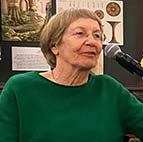

Why is 2018 such a significant year?
2018 is the centenary of winning Votes for Women. On 6 February 1918, the suffrage campaign was victorious - at long last ! Women over 30 (or at least the great majority of them) finally won the right to vote in parliamentary elections. (Votes for all women over the age of 21 was achieved only in 1928 - full equal voting rights with men.) So I'm definitely celebrating on 6 February!
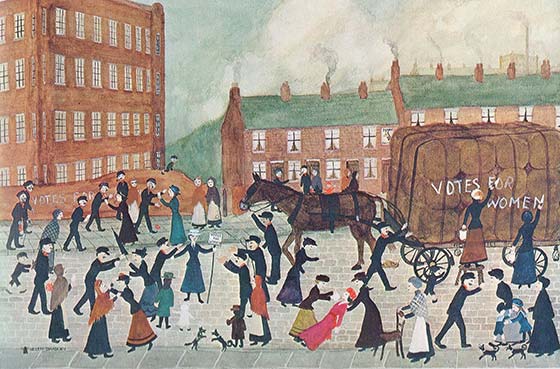
Helen Bradley, Miss Carter Came with Us, 1973. Annie Kenney speaking in Oldham.
Why was 1918 so important a victory?
The struggle for women to win the vote on equal terms with men had begun half-a-century earlier. In 1866 a women's suffrage petition was presented to Parliament. The National Union of Women's Suffrage Societies (NUWSS) was formed in 1897, led by Millicent Fawcett. Radical Suffragists. And in 1903 Emmeline Pankhurst formed the Women's Social and Political Union (WSPU), which soon adopted militant tactics.
However, any real progress soon got bogged down at Westminster in party political stalemate. When anti-suffrage Asquith became Prime Minister in 1908, women's suffrage campaigners responded to this challenge with a rich range of imaginative propaganda: banners, vanners, processions. In Rebel Girls I wrote about Colne Valley banner-maker Florence Lockwood; and about one caravan tour across Yorkshire - including Whitby harbour. I particularly like this photo, as it captures both the speaker and her audience.
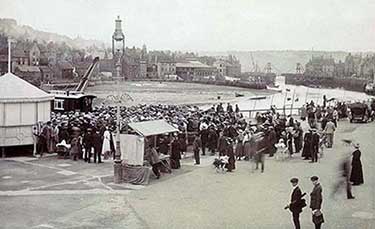
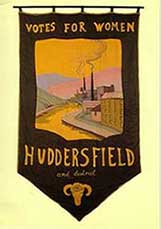
Left: NUWSS van at Whitby, Aug 1908.
The Women's Library.
Right: Florence Lockwood's banner. Tolson Museum, Huddersfield.
Why was the women's suffrage campaign so prolonged?
Campaigners used a variety of techniques: NUWSS suffragists relied on constitutional tactics (keeping within the law), while suffragettes in the WSPU deployed militant techniques: breaking the law & so risking imprisonment. The struggle with Asquith's Liberal Government grew increasingly bitter - especially from 1909 when it began forcibly feeding hunger-striking suffragettes in prison.
Before long, observers looking across the English Channel were aghast. Here was Edwardian Britain, the world's first industrial nation, which had become 'the storm-centre of the women's rebellion'. Yet Asquith's Government still was no nearer to enacting Votes for Women.

Punch, 20 July 1910
So how did win women the vote?
In spring 1911, suffragettes boycotted the census in protest, proclaining 'No Vote, No Census!' There were thousands of boycotters - yet not one single arrest. 1911 Census. Indeed, it became a summer of optimism, with 40,000 suffragettes and suffragists marching in procession shoulder to shoulder.
By 1913, however, betrayal by Asquith further sharpened political tensions, with WSPU arson attacks and the death of Emily Wilding Davison. How could campaigners get the government to back a bill giving women the vote? That summer, the NUWSS organized an impressive Women's Suffrage Pilgrimage. From all corners of Britain, pilgrims reached out to local communities ~ and did indeed succeed in getting Asquith's ear. Selina Cooper. So why did women win the vote in 1918? Leeds Suffrage Stories
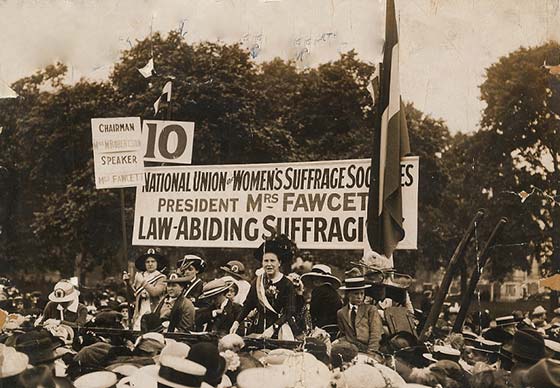
1913 pilgrimage, Selina Cooper & Mrs Fawcett, speaking in Hyde Park.
So what is happening in 2018?
Celebrations are planned right around the country. Vote 100 at the Houses of Parliament is co-ordinating plans. Many of these events take place in London. But, crucially, the demand by Edwardian campaigners was: 'Votes for Women ~ everywhere!' So 2018 offers every one of us the opportunity to celebrate the suffragist down our street, the suffragette in our town at vote100.uk.
What am I doing during 2018?
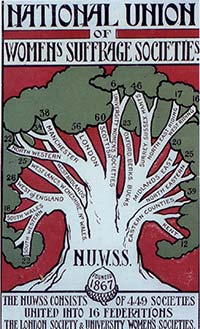 Vote 100 is an opportunity for me to take a breath from suffrage research and writing. About Jill Liddington. Recently, I was invited to give a talk at the Houses of Parliament: 'What do women do in Archives? Reflecting on suffrage research across four decades', comparing what we knew then & what we know now. What do Women do in Archives?
Vote 100 is an opportunity for me to take a breath from suffrage research and writing. About Jill Liddington. Recently, I was invited to give a talk at the Houses of Parliament: 'What do women do in Archives? Reflecting on suffrage research across four decades', comparing what we knew then & what we know now. What do Women do in Archives?
Now, I'm putting into practice my mantra: 'Votes for Women - everywhere!' I'll be speaking in local towns and cities, if not right across England at least across much of the north of England - and beyond. Vote100.uk events
Right: NUWSS Acorn - The Women's Library.
There'll also be magnificent celebrations in and around the Houses of Parliament ~ whose doors were shut to all women for so long! Now joining men like Nelson Mandela and Winston Churchill in Parliament Square is Dame Millicent Fawcett herself ~ the first ever woman with a statue there! This is a fitting tribute to the dignified suffragist leader, president of the great NUWSS - whose branches spread right across the whole of Britain: Fawcett Society
Women's suffrage histories Publications.
Also coming up ~ a new eBook edition of Presenting the Past & Sally Wainwright's TV drama series. See Anne Lister.